Lung Cancer – Risk Factors, Diagnosis, Symptoms, And Treatment
Lung cancer-Causes, diagnosis, symptoms, and treatment
Lung cancer is the most dreadful cancer and accounts for almost 27%, of all cancer deaths in the country. People have started giving up smoking with increased awareness about lung cancer.
Abnormal growth of cells either on one or both the lungs is leads to lung cancer. It usually affects the cells that line the air passage. They divide and form tumors which, in turn, hinder the lungs from providing oxygen to the bloodstream. Tumors that do not spread are known as benign. These are not too dangerous. However, the tumors that spread and affect the other organs are called malignant and these are dangerous.

Below is some information about the risk factors, the diagnosis, the symptoms, and the treatment options of lung cancer.
What are the risk factors for lung cancer?
- Cigarette smoking and use of tobacco products in the form of cigars and pipes are the main cause for lung cancer. Tobacco smoke is poisonous and can also lead to cancer in secondhand smokers (passive smokers). Smoking can also cause cancer in the mouth and throat, larynx (voice box), trachea, bronchus, esophagus, stomach, colon, rectum, liver, pancreas, kidney and renal, pelvis, urinary bladder, as well as the cervix.
How is lung cancer diagnosed?
- Lung cancer can go undetected until it has spread or reached advanced stages. If a patient feels that he/she could be at the risk of developing lung cancer, they must immediately consult their doctors and get themselves tested.
- If the patient has persistent coughing with blood in their sputum, they can get their sputum tested to see if there are cancerous cells. This process is known as sputum cytology.
- Early onset of lung cancer can be determined through X-rays or computed tomography (CT) scans. These tests will reveal if there are any odd and abnormal growths or lesions in the lungs.
- Depending on the stage of the cancer, further scans like positron emission tomography (PET), magnetic resonance imaging (MRI), and bone scans may be done to get more clarity of the cancer and to decide the treatment plan. Tests are case specific so it is best to go through the ones advised by the doctor.
What are the symptoms of lung cancer?
- Lung cancer does not have a single type of symptom. It can be different in every case. Many a times it goes undetected until it has spread to other organs.
- Common symptoms include continuous coughing with blood in the sputum, chest pain, tiredness, and unexplained weight loss.
- Sometimes, the patient may suffer from continuous bouts of pneumonia and enlarged or swollen lymph nodes between the lungs causing a pressure in the chest.
What is the treatment procedure for lung cancer?
The treatment plan for lung cancer is decided by the doctor depending upon the requirement and the stage of cancer. Some treatment plans commonly used for lung cancer are:
- Surgery – If the cancer is confined to the lungs, then surgery is often recommended by the doctor. During the surgery, the surgeon removes the cancerous growth, as well a small part of the healthy tissue.
- Radiation therapy – This is often combined with chemotherapy and can be done before or after surgery depending on the necessity. This therapy uses radiation of high-powered beams from protons and X-rays to kill the cancerous cells.
- Chemotherapy – Chemotherapy is often done after surgery to kill any leftover cancerous cells. It involves the use of drugs that are either taken orally or given intravenously.
- Other options – There are many more treatment methods used for lung cancer like immunotherapy, radiosurgery, targeted drug therapy, etc. There are also clinical trials that a patient can enrol into, wherein doctors test new drugs and treatments depending on the type of cancer.

